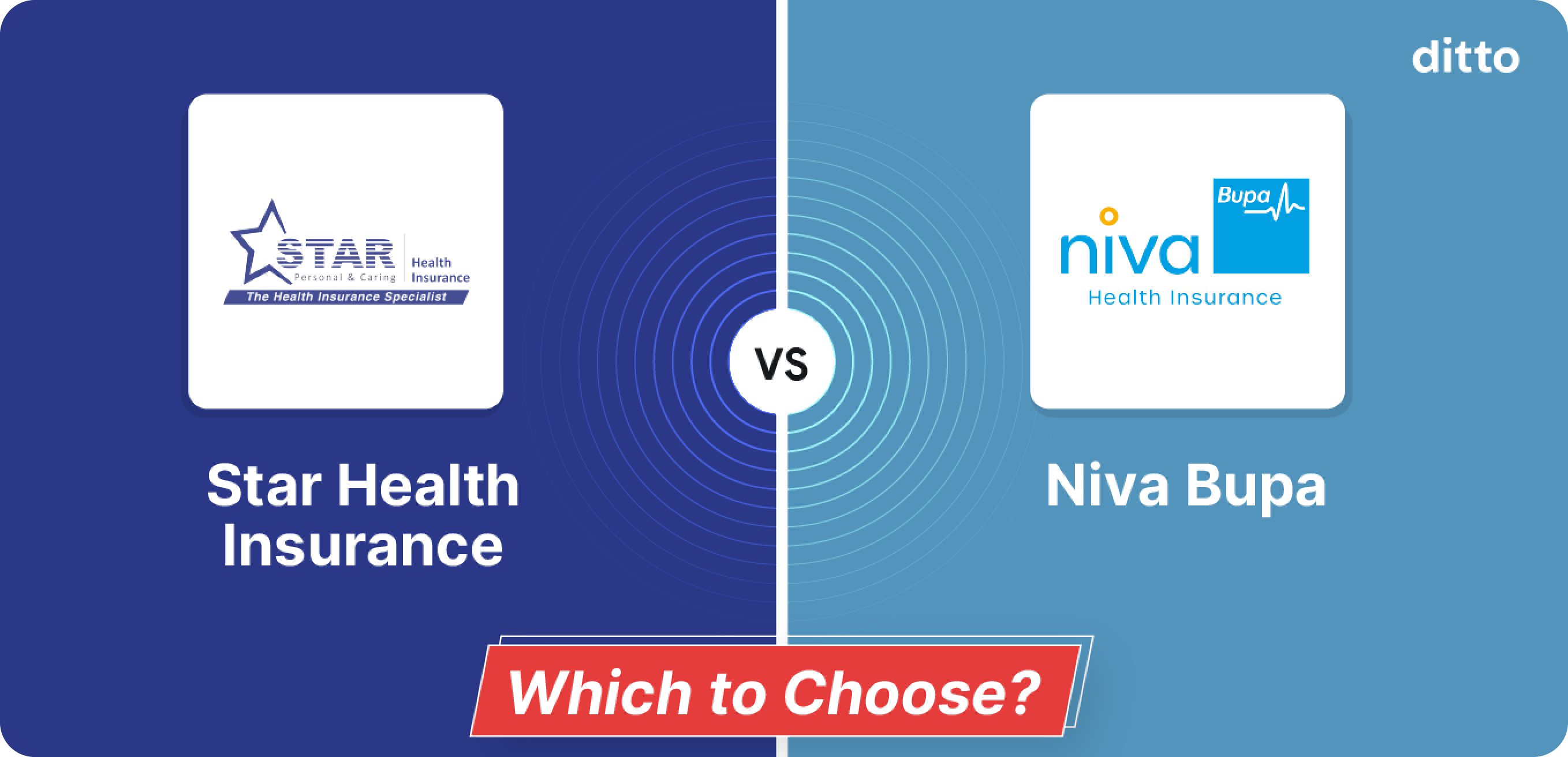Star Health Insurance vs Niva Bupa: Which to Choose in 2025?
In 2025, both Star Health and Niva Bupa are leading insurers in the insurance industry. Star Health has a larger network of hospitals and a wider presence. However, Niva performs better with a higher claim settlement ratio(CSR) and fewer complaints.
Introduction
Choosing between Star Health and Niva Bupa can be a difficult decision. Both insurers offer decent health policies but have mixed claim experiences. Star stands out for customer reach, while Niva Bupa focuses on innovation.
At Ditto, we’ve studied both insurers closely to help you choose the one that truly fits your needs. This guide helps you understand:
- About the two insurers and their metrics
- Plans offered and premium structure
- Expert tips on what to purchase
Confused about which insurer suits your needs? Connect with our IRDAI-certified experts for free and get spam-free advice on your insurance decisions. Book a call now!
Star Health Insurance vs Niva Bupa: Key Insurer Metrics
Note: The data and insights for this article are sourced from IRDAI and Insurer public disclosures.
About Star Health Insurance
Star Health Insurance, established in 2006, is one of India's oldest private health insurance companies, with its headquarters in Chennai. It gained people's trust through its extensive agent network and strong market presence.
But in recent years, its performance has dropped. Many customers faced issues like rejected claims, delisted hospitals, and data breach. Although it offers comprehensive policies, poor service has led people to seek more reliable insurers.
About Niva Bupa Health Insurance
Niva Bupa, formerly known as Max Bupa, was established in 2008, and is a joint venture between Fettle Tone LLP (True North) and Bupa Singapore Holdings. It is known for its affordable health plans.
However, recently, many customers have encountered service-related issues. The growing complaints indicate a decline in performance, which could impact the company’s growth and reputation.
Star Health Insurance vs Niva Bupa: Premium Comparison
Premiums for a sum insured of 15 lakh in Delhi
Star Health Insurance vs Niva Bupa: Plan Comparison
Star vs Niva Bupa Health Insurance: Which is Better?
Star Health has faced scrutiny from IRDAI and a high number of customer complaints. Niva Bupa, on the other hand, offers plans such as ReAssure 2.0 and Aspire, which come with strong benefits and fair pricing.
Our take? While both Star and Niva Bupa are partner insurers of ours, we do not currently actively recommend them due to higher complaints and inconsistent claims experiences.
While Niva has shown signs of improvement, we are still waiting and watching. That being said, there are better insurers to consider, such as HDFC, CARE and Aditya Birla, which are decent in terms of post-sales and claims experience.
Click here to read more about plans that make Ditto’s cut.
Why Talk to Ditto for Your Health Insurance?
At Ditto, we’ve assisted over 8,00,000 customers with choosing the right insurance policy. Why customers like Arun below love us:

✅No-Spam & No Salesmen
✅Rated 4.9/5 on Google Reviews by 5,000+ happy customers
✅Backed by Zerodha
✅100% Free Consultation
You can book a FREE consultation. Slots are running out, so make sure you book a call now!
Star Health Insurance vs Niva Bupa: Final Thoughts
Both Star Health and Niva Bupa offer good coverage but vary in claim reliability. It’s best to compare other insurers and choose based on service quality.
FAQs
Which is better in 2025: Star Health or Niva Bupa?
Star Health offers a larger hospital network, while Niva Bupa provides flexible and innovative plans.
Which insurer has a better claim settlement ratio?
Niva Bupa performs better with a 92% claim settlement ratio, compared to Star Health’s 85%.
Why has Star Health faced more complaints?
Customers have reported issues like claim rejections, delisted hospitals, and sudden plan changes.
Are Niva Bupa’s Aspire and ReAssure 2.0 plans worth it?
Yes, these plans include helpful features like “Lock the Clock” and “Miracle Benefit.”
Does Niva Bupa offer better maternity benefits?
Yes. Niva Bupa’s Aspire plan offers broader maternity and newborn care than Star Health.
Last updated on:










